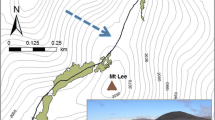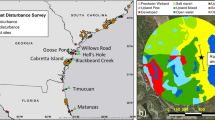Abstract
Ecosystem-engineering plants modify the physical environment and can increase species diversity and exotic species invasion. At the individual level, the effects of ecosystem engineers on other plants often become more positive in stressful environments. In this study, we investigated whether the community-level effects of ecosystem engineers also become stronger in more stressful environments. Using comparative and experimental approaches, we assessed the ability of a native shrub (Ericameria ericoides) to act as an ecosystem engineer across a stress gradient in a coastal dune in northern California, USA. We found increased coarse organic matter and lower wind speeds within shrub patches. Growth of a dominant invasive grass (Bromus diandrus) was facilitated both by aboveground shrub biomass and by growing in soil taken from shrub patches. Experimental removal of shrubs negatively affected species most associated with shrubs and positively affected species most often found outside of shrubs. Counter to the stress-gradient hypothesis, the effects of shrubs on the physical environment and individual plant growth did not increase across the established stress gradient at this site. At the community level, shrub patches increased beta diversity, and contained greater rarified richness and exotic plant cover than shrub-free patches. Shrub effects on rarified richness increased with environmental stress, but effects on exotic cover and beta diversity did not. Our study provides evidence for the community-level effects of shrubs as ecosystem engineers in this system, but shows that these effects do not necessarily become stronger in more stressful environments.






Similar content being viewed by others
References
Alpert P, Mooney HA (1996) Resource heterogeneity generated by shrubs and topography on coastal sand dunes. Vegetation 122:83–93. doi:10.1007/BF00052818
Anderson MJ, Crist TO, Chase JM, Vellend M, Inouye BD, Freestone AL, Sanders NJ, Cornell HV, Comita LS, Davies KF, Harrison SP, Kraft NJB, Stegen JC, Swenson NG (2011) Navigating the multiple meanings of β diversity: a roadmap for the practicing ecologist. Ecol Lett 14:19–28. doi:10.1111/j.1461-0248.2010.01552.x
Armas C, Rodríguez-Echeverría S, Pugnaire FI (2011) A field test of the stress-gradient hypothesis along an aridity gradient. J Veg Sci 22:818–827. doi:10.1111/j.1654-1103.2011.01301.x
Badano EI, Cavieres LA (2006) Ecosystem engineering across ecosystems: do engineer species sharing common features have generalized or idiosyncratic effects on species diversity? J Biogeogr 33:304–313. doi:10.1111/j.1365-2699.2005.01384.x
Badano EI, Jones C, Cavieres L, Wright J (2006) Assessing impacts of ecosystem engineers on community organization: a general approach illustrated by effects of a high-Andean cushion plant. Oikos 115:369–385. doi:10.1111/j.2006.0030-1299.15132.x
Badano EI, Villarroel E, Bustamante RO, Marquet PA, Cavieres LA (2007) Ecosystem engineering facilitates invasions by exotic plants in high-Andean ecosystems. J Ecol 95:682–688. doi:10.1111/j.1365-2745.2007.01262.x
Barbour MG, Craig RB, Drysdale FR, Ghiselin MT (1973) Coastal ecology: Bodega Head. University of California Press, Berkeley
Bertness MD, Callaway R (1994) Positive interactions in communities. Trends Ecol Evol 9:191–193. doi:10.1016/0169-5347(94)90088-4
Bonanomi G, Rietkerk M, Dekker SC, Mazzoleni S (2008) Islands of fertility induce co-occurring negative and positive plant–soil feedbacks promoting coexistence. Plant Ecol 197:207–218. doi:10.1007/s11258-007-9371-0
Brooker R, Kikvidze Z, Pugnaire FI et al (2005) The importance of importance. Oikos 109:63–70. doi:10.1111/j.0030-1299.2005.13557.x
Bruno JF, Stachowicz JJ, Bertness MD (2003) Inclusion of facilitation into ecological theory. Trends Ecol Evol 18:119–125. doi:10.1016/S0169-5347(02)00045-9
Butterfield BJ, Cavieres LA, Callaway RM, Cook BJ, Kikvidze Z, Lortie CJ, Michalet R, Pugnaire FI, Schöb C, Xiao S, Zaitchek B, Anthelme F, Björk RG, Dickinson K, Gavilán R, Kanka R, Maalouf JP, Noroozi J, Parajuli R, Phoenix GK, Reid A, Ridenour W, Rixen C, Wipf S, Zhao L, Brooker RW (2013) Alpine cushion plants inhibit the loss of phylogenetic diversity in severe environments. Ecol Lett 16:478–486. doi:10.1111/ele.12070
Callaway RM, Kikodze D, Chiboshvili M, Khetsuriani L (2005) Unpalatable plants protect neighbors from grazing and increase plant community diversity. Ecology 86:1856–1862. doi:10.1890/04-0784
Carlsson BA, Callaghan TV (1991) Positive plant interactions in tundra vegetation and the importance of shelter. J Ecol 79:973–983. doi:10.2307/2261092
Cavieres LA, Badano EI (2009) Do facilitative interactions increase species richness at the entire community level? J Ecol 97:1181–1191. doi:10.1111/j.1365-2745.2009.01579.x
Cuddington K, Byers JE, Wilson WG, Hastings A (2007) Ecosystem engineers: plants to protists. Academic, New York
Cushman JH, Waller JC, Hoak DR (2010) Shrubs as ecosystem engineers in a coastal dune: influences on plant populations, communities and ecosystems. J Veg Sci 21:821–831. doi:10.1111/j.1654-1103.2010.01196.x
Cushman JH, Lortie CJ, Christian CE (2011) Native herbivores and plant facilitation mediate the performance and distribution of an invasive exotic grass. J Ecol 99:524–531. doi:10.1111/j.1365-2745.2010.01776.x
De Villiers AJ, Van Rooyen MW, Theron GK (2001) The role of facilitation in seedling recruitment and survival patterns, in the Strandveld Succulent Karoo, South Africa. J Arid Environ 49:809–821. doi:10.1006/jare.2001.0823
Facelli JM, Temby AM (2002) Multiple effects of shrubs on annual plant communities in arid lands of South Australia. Austral Ecol 27:422–432. doi:10.1046/j.1442-9993.2002.01196.x
Forey E, Lortie CJ, Michalet R (2009) Spatial patterns of association at local and regional scales in coastal sand dune communities. J Veg Sci 20:916–925. doi:10.1111/j.1654-1103.2009.01095.x
Gotelli NJ, Colwell RK (2001) Quantifying biodiversity: procedures and pitfalls in the measurement and comparison of species richness. Ecol Lett 4:379–391. doi:10.1046/j.1461-0248.2001.00230.x
Griffith AB (2010) Positive effects of native shrubs on Bromus tectorum demography. Ecology 91:141–154. doi:10.1890/08-1446.1
Gutiérrez JR, Meserve PL, Contreras LC, Vásquez H, Jaksic FM (1993) Spatial distribution of soil nutrients and ephemeral plants underneath and outside the canopy of Porlieria chilensis shrubs (Zygophyllaceae) in arid coastal Chile. Oecologia 95:347–352. doi:10.1007/BF00320987
Hacker SD, Gaines SD (1997) Some implications of direct positive interactions for community species diversity. Ecology 78:1990–2003. doi:10.2307/2265939
He Q, Bertness MD, Altieri AH (2013) Global shifts towards positive species interactions with increasing environmental stress. Ecol Lett 16:695–706. doi:10.1111/ele.12080
Holmgren M, Scheffer M (2010) Strong facilitation in mild environments: the stress gradient hypothesis revisited. J Ecol 98:1269–1275. doi:10.1111/j.1365-2745.2010.01709.x
Holzapfel C, Mahall BE (1999) Bidirectional facilitation and interference between shrubs and annuals in the Mojave Desert. Ecology 80:1747–1761. doi:10.1890/0012-9658(1999)080[1747:BFAIBS]2.0.CO;2
Holzapfel C, Tielborger K, Parag HA, Kigel J, Sternberg M (2006) Annual plant–shrub interactions along an aridity gradient. Basic Appl Ecol 7:268–279. doi:10.1016/j.baae.2005.08.003
Jones CG, Lawton JH, Shachak M (1994) Organisms as ecosystem engineers. Oikos 69:373–386. doi:10.2307/3545850
Jury W, Horton R (2004) Soil physics, 6th edn. Wiley, Hoboken
Kutiel P, Danin A (1987) Annual-species diversity and aboveground phytomass in relation to some soil properties in the sand dunes of the northern Sharon Plains, Israel. Vegetation 70:45–49
Lortie CJ, Cushman JH (2007) Effects of a directional abiotic gradient on plant community dynamics and invasion in a coastal dune system. J Ecol 95:468–481. doi:10.1111/j.1365-2745.2007.01231.x
Maestre FT, Callaway RM, Valladares F, Lortie CJ (2009) Refining the stress-gradient hypothesis for competition and facilitation in plant communities. J Ecol 97:199–205. doi:10.1111/j.1365-2745.2008.01476.x
Maron JL, Connors PG (1996) A native nitrogen-fixing shrub facilitates weed invasion. Oecologia 105:302–312. doi:10.1007/BF00328732
McNeil SG, Cushman JH (2005) Indirect effects of deer herbivory on local nitrogen availability in a coastal dune ecosystem. Oikos 110:124–132. doi:10.1111/j.0030-1299.2005.13686.x
Oksanen J, Blanchet FG, Kindt R, Legendre P, Minchin PR, O’Hara RB, Simpson GL, Solymos P, Stevens MHH, Wagner H (2013) vegan: Community Ecology Package. R package version 2.0-9. http://CRAN.R-project.org/package=vegan
Pinheiro J, Bates D, DebRoy S, Sarkar D, R Development Core Team (2013) nlme: Linear and Nonlinear Mixed Effects Models. R package version 3.1-111. http://CRAN.R-project.org/package=nlme
Pugnaire FI, Luque MT (2001) Changes in plant interactions along a gradient of environmental stress. Oikos 93:42–49. doi:10.1034/j.1600-0706.2001.930104.x
Pugnaire FI, Haase P, Puigdefábregas J, Cueto M, Clark SC, Incoll LD (1996) Facilitation and succession under the canopy of a leguminous shrub, Retama sphaerocarpa, in a semi-arid environment in south-east Spain. Oikos 76:455–464. doi:10.2307/3546339
R Core Team (2013) R: a language and environment for statistical computing. R Foundation for Statistical Computing, Vienna
Sankey JB, Germino MJ, Sankey TT, Hoover AN (2012) Fire effects on the spatial patterning of soil properties in sagebrush steppe, USA: a meta-analysis. Int J Wildland Fire 21:545. doi:10.1071/WF11092
Schlesinger WH, Reynolds JF, Cunningham GL, Huenneke LF, Jarrell WM, Virginia RA, Whitford WG (1990) Biological feedbacks in global desertification. Science 247:1043–1048. doi:10.1126/science.247.4946.1043
Schöb C, Butterfield BJ, Pugnaire FI (2012) Foundation species influence trait-based community assembly. New Phytol 196:824–834. doi:10.1111/j.1469-8137.2012.04306.x
Shirazi MA, Boersma L (1984) A unifying quantitative analysis of soil texture. Soil Sci Soc Am J 48:142. doi:10.2136/sssaj1984.03615995004800010026x
Shumway SW (2000) Facilitative effects of a sand dune shrub on species growing beneath the shrub canopy. Oecologia 124:138–148. doi:10.1007/s004420050033
Tewksbury JJ, Lloyd JD (2001) Positive interactions under nurse-plants: spatial scale, stress gradients and benefactor size. Oecologia 127:425–434. doi:10.1007/s004420000614
Tielbörger K, Kadmon R (2000) Indirect effects in a desert plant community: is competition among annuals more intense under shrub canopies? Plant Ecol 150:53–63. doi:10.1023/A:1026541428547
Valiente-Banuet A, Ezcurra E (1991) Shade as a cause of the association between the cactus Neobuxbaumia tetetzo and the nurse plant Mimosa luisana in the Tehuacan Valley, Mexico. J Ecol 79:961–971
Valiente-Banuet A, Verdu M (2007) Facilitation can increase the phylogenetic diversity of plant communities. Ecol Lett 10:1029–1036. doi:10.1111/j.1461-0248.2007.01100.x
Zhao HL, Zhou RL, Su YZ, Zhang H, Zhao LY, Drake S (2007) Shrub facilitation of desert land restoration in the Horqin sand land of Inner Mongolia. Ecol Eng 31:1–8. doi:10.1016/j.ecoleng.2007.04.010
Acknowledgments
We are grateful to the following individuals for assistance in the field: Drew Carlson, Nicole Christie, Rayma Cooley, Kara Doolin, Krista Lindley, Devin Moorad, Stephanie Parreira, Avi Starr-Glass, and Woody Wu. Jackie Sones of the UC Davis Bodega Marine Reserve provided valuable logistical support. Janis Boettinger provided advice on soil analyses and performed organic carbon analysis. Peter Adler, Chengjin Chu, Caroline Christian, Susan Harrison, David Pyke, and two anonymous reviewers provided comments on the manuscript and/or study design. Research support was provided by grants from the California Native Plant Society, Northern California Botanists, Sigma Xi Grants-in-Aid of Research Program, Sonoma State University, and the National Science Foundation (DEB-9981663 to J.H.C.).
Author information
Authors and Affiliations
Corresponding author
Additional information
Communicated by David A. Pyke.
Electronic supplementary material
Below is the link to the electronic supplementary material.
Rights and permissions
About this article
Cite this article
Kleinhesselink, A.R., Magnoli, S.M. & Cushman, J.H. Shrubs as ecosystem engineers across an environmental gradient: effects on species richness and exotic plant invasion. Oecologia 175, 1277–1290 (2014). https://doi.org/10.1007/s00442-014-2972-0
Received:
Accepted:
Published:
Issue Date:
DOI: https://doi.org/10.1007/s00442-014-2972-0




